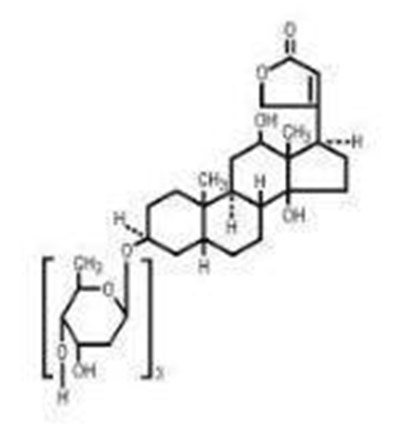Product Images Digoxin
View Photos of Packaging, Labels & Appearance
Product Label Images
The following 9 images provide visual information about the product associated with Digoxin NDC 52584-410 by General Injectables And Vaccines, Inc, such as packaging, labeling, and the appearance of the drug itself. This resource could be helpful for medical professionals, pharmacists, and patients seeking to verify medication information and ensure they have the correct product.
Image1.jpg - Image1
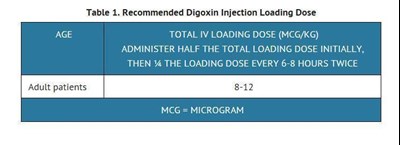
The text provides a table indicating the recommended digoxin injection loading dose in micrograms per kilogram for adult patients. It suggests administering half of the total loading dose initially and then % the loading dose every 6-8 hours twice.*
Image2.jpg - Image2
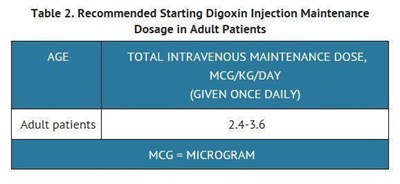
This is a table showing the recommended starting maintenance dosage of Digoxin Injection for adult patients. The dosage is given intravenously once daily and is measured in micrograms (mcg).*
Image3.jpg - Image3
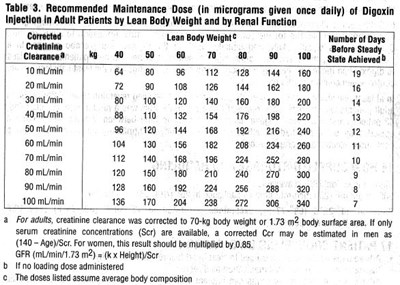
The given text describes recommended maintenance dose of Digoxin injection for adult patients based on their lean body weight and renal functions. The table presents the recommended dose for patients based on their body weight and GFR rates. The text also explains how to estimate creatinine clearance in case serum creatinine concentrations are only available. The doses mentioned are assuming average body composition and do not include any loading dose.*
Image4.jpg - Image4

This table compares the systemic availability and equivalent doses of the oral drug LDinuxin Tablets and the intravenous drug joxin Injection. LDinuxin Tablets have a bioavailability of 60-80% and the equivalent doses in mcg for tablets are 625, 125, 250 and 500. joxin Intravenous Injection has 100% bioavailability and the equivalent doses in mcg for injection are 50, 100, 200 and 400.*
Image5.jpg - Image5
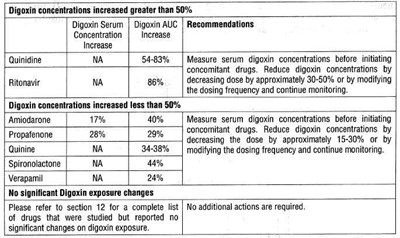
This text provides recommendations for adjusting digoxin dosages when used in combination with certain drugs. It suggests measuring digoxin concentrations and reducing doses by specific percentages or modifying dosing frequencies to avoid potentially harmful increases in digoxin serum levels. There is also a list of drugs that have been studied and found to have no significant impact on digoxin exposure.*
Image6.jpg - Image6

This text contains information on how certain drugs can affect the excretion and function of digoxin, which is a medication used to treat heart conditions. Drugs like ACE inhibitors, angiotensin receptor blockers, and nonsteroidal anti-inflammatory drugs can impair the excretion of digoxin, while others like sotalol and dronedarone can increase the risk of proarrhythmias when taken with digoxin. Hypercalcemia caused by drugs such as teriparatide can also predispose patients to digoxin toxicity. Additionally, taking sympathomimetics like epinephrine or dopamine can increase the risk of cardiac arrhythmias, while neuromuscular blocking agents like succinylcholine can cause sudden extrusion of potassium from muscle cells, leading to arrhythmias. Calcium and other substances, if administered rapidly by intravenous route, can produce serious arrhythmias in digitized patients. Finally, some drugs may have additive effects on AV node conduction, resulting in bradycardia and advanced or complete heart block.*
Image8.jpg - Image8

Table 5 shows the times it takes for the pharmacologic effect and the peak effect to occur for different preparations of Digoxin. The onset of effect for Digoxin Tablets is between 0.5-2 hours, while for Digoxin Injection/IV, it takes 5-30 minutes for the effect to start depending on the rate of infusion. These effects have been documented for ventricular response rate in atrial fibrillation, inotropic effects, and electrocardiographic changes.*
Label1.jpg - Label1
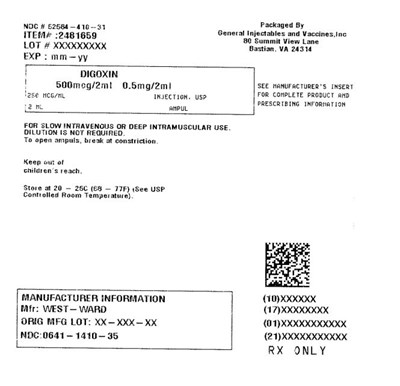
This is a product label for a medication called Digoxin, which comes in an injectable form. It is manufactured by West-Ward and used for slow intravenous or deep intramuscular use. Dilution is not required. The medication comes in an ampule that should be broken at the constriction to open. The label also includes storage instructions and cautions to keep the medication out of reach of children. Additional information can be found in the manufacturer's insert for complete product and prescribing information.*
* The product label images have been analyzed using a combination of traditional computing and machine learning techniques. It should be noted that the descriptions provided may not be entirely accurate as they are experimental in nature. Use the information in this page at your own discretion and risk.
